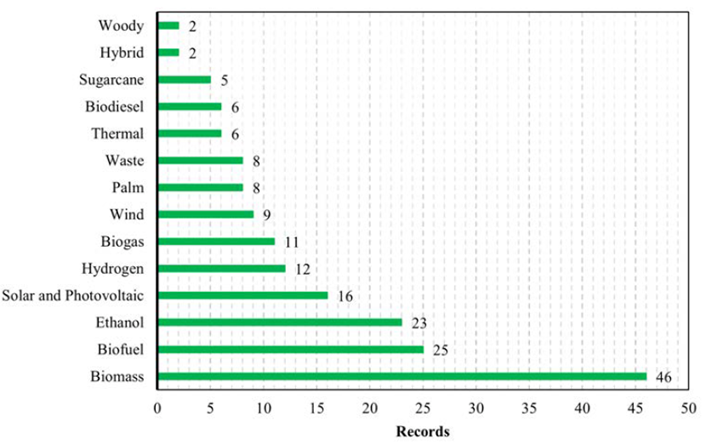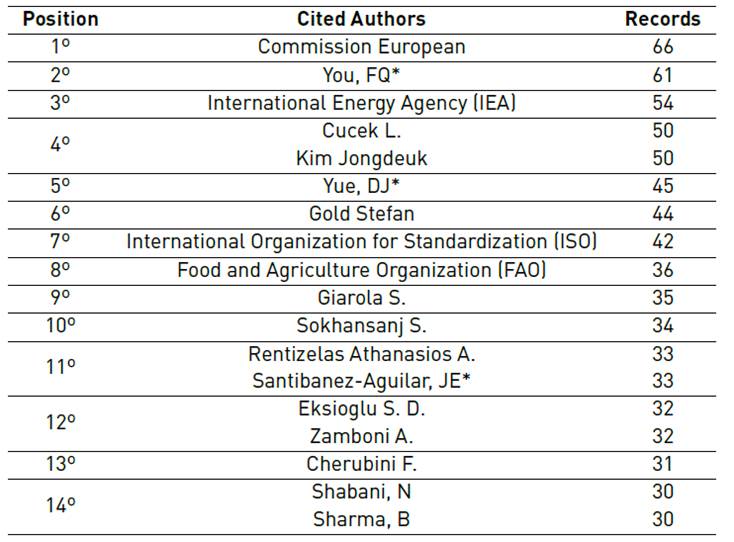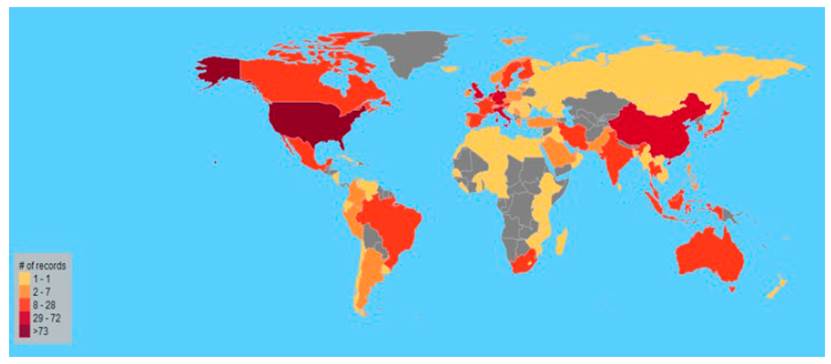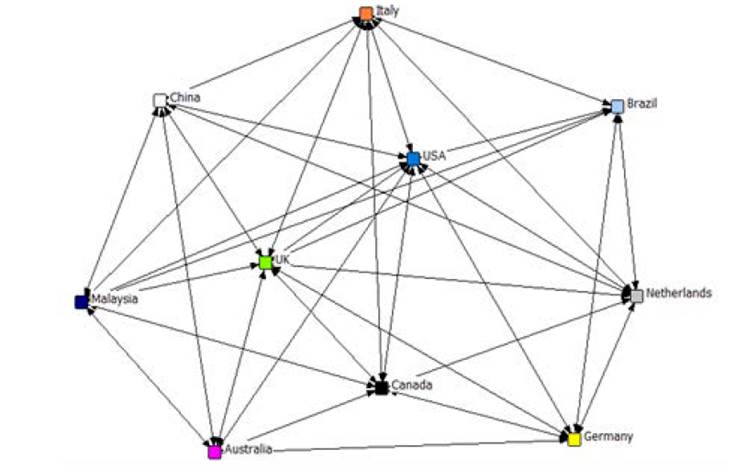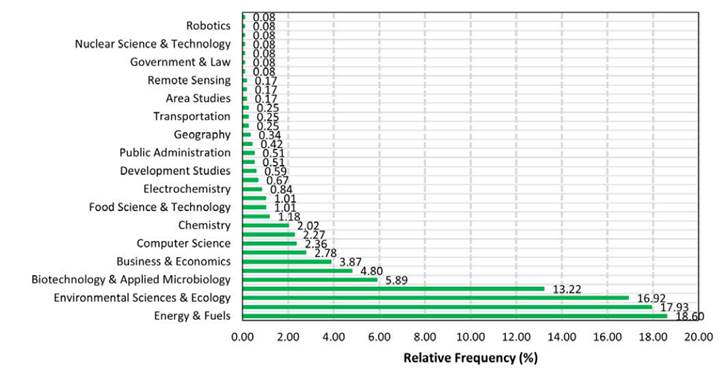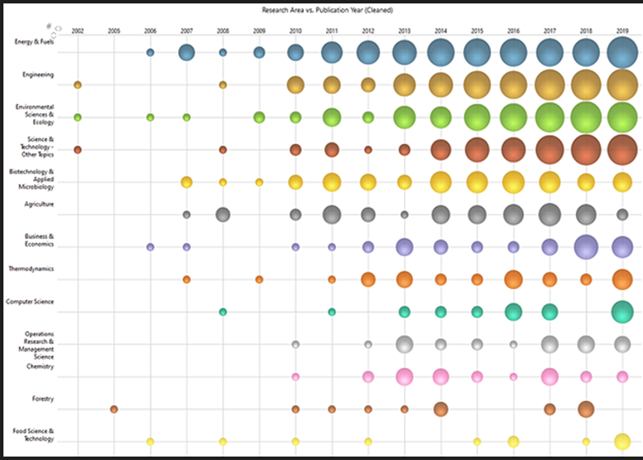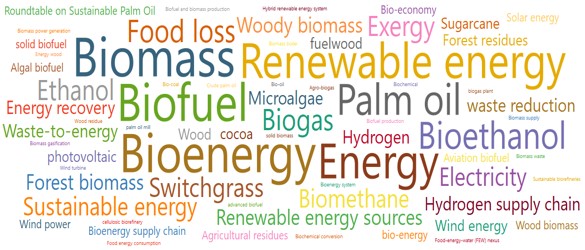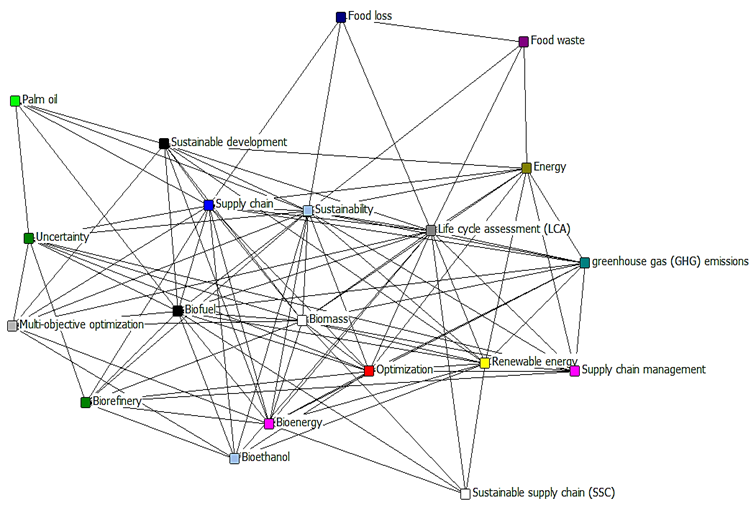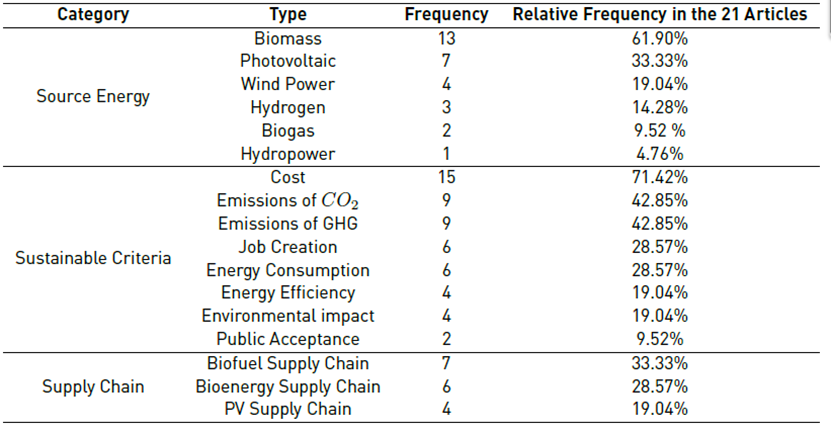1. Introduction
The concern about global warming has been increasing over the years 1,2, especially after Kyoto Protocol and Paris Agreement established targets in order to reduce the greenhouse gases - GHG emissions’ levels 3. It is scientifically proven that global warming is caused by GHG emissions, especially carbon dioxide (CO2), which is also generated by fossil fuel combustion processes 4-6 . According to some authors 7-9, the industrial sector contributes with one-half of the global energy consumption. It puts the industrial sector as the second major consumer of energy - according to IEA (International Energy Agency), it consumed 2,839,313 ktoe (kilotonnes of oil equivalent) in 2018, behind only the transport sector that consumed 2,890,900 ktoe 10.
In this context, the supply chain is intensive in energy consumption since it involves different echelons (from raw material to manufacturing, and delivering the products for clients; sometimes, even the recycling and disposal) and process (as manufacturing, transportation, and storage). Nevertheless, the total energy consumption of each stage will depend on different features, as: whether it is a closed-loop supply chain or not, the number of echelons, the type of transformation process and technology used, where each echelon are located, which means of transportation are available and so on. In addition, Machi and Zanoni 11 explain that the total energy consumption depends on the sector and/or the product under assessment, since each of them has its own particularities. Therefore, biorefinery supply chains are different from wine or automobile supply chains.
Despite the type of supply chain, in order to reduce the energy consumption and GHG emissions, one of the solutions studied and implemented over the years is the use of renewable energies 12,13, which covers a wide use of different technologies, as photovoltaic energy 14, hydrogen 15, wind energy 16, biogas for cogeneration 17 and many others 18-20.
According to Eurostat data (September 2020) 21 presented in Figure 1, the energy balance of renewable sources increased by almost 6% in all European Union in the last 10 years. Among the EU countries, Portugal stands out with the highest share of renewable sources in its matrix (ranging from 25% to 30% over the years). Another important fact is the growth of renewable energies in Brazil, which energy matrix include hydro, wind, solar, and bioenergy sources. According to the Brazilian Ministry of Mines and Energy 22, the renewable energy (RE) sources used in the country reached 46.1% of participation in the 2019 energy matrix, increasing 0.6% in relation to 2018.
In relation to other parts of the world, considering the participation of primary energy from renewable sources, Canada (27.63% in 2019) stands out in North America, Ecuador (30.38% in 2019) in South America (after Brazil, as presented in the previous paragraph), Morocco (7.09% in 2019) in Africa, Vietnam (15.22% in 2019) and China (12.66% in 2019) in Asia, Turkey (18.47%) in the Middle East and New Zealand (35.4% in 2019) in Oceania 23
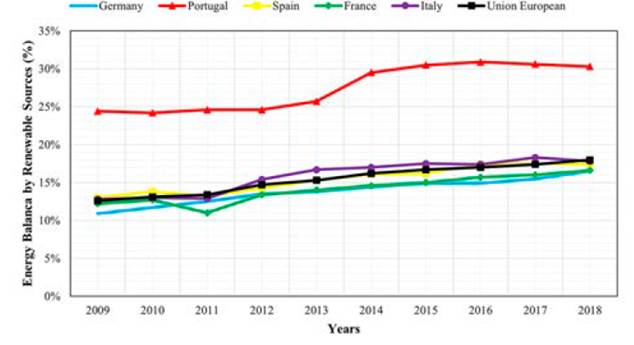
(Source: Eurostat adapted by the authors 21)
Figure 1 Energy balance from renewable sources for European Union and other countries (2020)
It is essential to mention that increasing the consumption of renewable energy could also reduce the dependence on fossil energy sources, promoting a greener development 24,25. It is important to highlight that the electricity and heat producers’ sector are the main sources of CO2 emission in all world, according to recent data from IEA (with 13,978 Mt CO2 in 2018) followed by the industrial sector (with 6,158 Mt CO2 in 2018) and transport (with 8,258 Mt CO2 in 2018) 26.
Nevertheless, in order to achieve sustainable development, it is necessary to deal with the economic, social and environmental dimensions 27-29. The sustainable concept was first proposed by Brutland Report in 1987 30 then discussed in important international forums around the world, as United Nation Conferences on Sustainable Development. Nowadays, one of the most recognized agreements related to sustainable development is the 2030 Agenda from the United Nations 31, which claims the relevance of combining economic growth, social development, and environmental conservation in order to achieve sustainable development.
Therefore, according to the WWF (World Wide Fund for Nature) and the goals of the 2030 Agenda, it is necessary to harmonize economic, social and environmental pillars 32. Notwithstanding, sometimes, social and environmental ones are not even taken into account (33, 34), as seen in studies about: biofuels supply chain 35,36, solid waste supply chain 37, additive manufacturing supply chain 38, pharmaceutical supply chain 39, and others.
As global energy demand has been quite increasing (according to data from Energy Information, 30% of the energy consumption will increase between 2020 and 2050) 40 , the business sector has still focused much of its efforts in developing actions to improve the economic performance, often leaving aside social and environmental aspects 41 . It might be related to the fact that quantifying these aspects is not always a simple task, bringing complexities in the development of decision-making support tools (including here mathematical optimization models) to support the decision related to the design of supply chains 42. For example, some authors point out that the incorporation of environmental and social aspects are a challenge to the supply chain for the next years 43,44; while others considering that incorporating the environmental aspect is a step toward sustainability, since there is not a consensual way to deal with the social concerns 45,46 . However, it is possible to visualize the recent efforts of researchers to consider the three dimensions that compose the sustainable concept in the literature 47-53.
In the context of renewable energies in the supply chain, it is possible to note that some studies do not cover the triple bottom line of the sustainable concept in their analysis. Liu et al. 54, for example, proposed an optimization model for a hybrid system that uses energy from solar concentration and biomass; however, their analysis quantifies only the economic and environmental scenarios, not referring to the social impact. Câmara et al. 55 also do not take into account the social dimension: a multi-objective optimization model is proposed to assist the decision-making in hydrogen supply chain design and planning, considering the cost (economic dimension) and carbon emissions (environmental dimension). However, there are investigations that consider the three sustainable pillars, as Kristianto and Zhu 56 , that model a sustainable supply chain of bio-ethanol.
Given the context presented in the previous paragraphs, the study performed in the present article was motivated by the following question: is the literature about sustainable supply chain investigating the use of renewable energy as eco-friendly policy? Therefore, this paper maps the role of renewable energies in the context of the sustainable supply chain, analyzing the literature published at Web of Science database - WoS until 2019. The main researchers, organizations, collaboration networks were presented, and the 21 most cited studies were mapped in this paper. This type of investigation is relevant since it might show some gaps and challenges to be fulfilled in future studies as well as help the academics to identify collaborations in potential. Note that we do not intend to address renewable energy as public policy, but we aim to investigate if there were studies about renewable energy among different kinds of studies performed in the literature about sustainable supply chain (as addressing circular economy or life cycle assessments).
It is relevant to mention that this paper is an extended version of “The Profile of Studies on Renewable Energy in Sustainable Supply Chain”, presented at ICSC-CITIES 2020, in which we could provide further analysis of the main results related to renewable energy and sustainable supply chain.
Following this introduction, the next sections will present the methodological procedures performed to gather and analyze the data (Section 2), as well the main findings and discussion (Section 3), followed by the final considerations (Section 4).
2. Methodological procedures
The methodological procedures involved a qualitative analysis of the literature and the use of techniques of descriptive statistics. Through a data mining process, the articles were obtained from the WoS database. The database was chosen due to its satisfactory scope and coverage (57, and for being used in papers with similar methodology as (58, 33). Table 1 shows the parameters of the search.
As you may note, at first, the study did not include any keyword related to renewable energy sources, since we decided to gather all the papers published about sustainable supply chain (or supply network) and then, select a frame for analysis (renewable energy). By doing that, we reduce the possible error related to the exclusion of papers that could be related to the subject but do not use a specific keyword as the indexation terms.
Once the search was done, the next phase was to determine the keywords that would be used to select our subset among the results. The selected keywords can be divided into three categories: (i) energy (as sustainable energy, electricity, bioenergy, wind energy, solar energy, solar photovoltaic and so on); (ii) bioenergy sources (as ethanol, palm oil, algal biofuel and so on); (iii) supply chain (biomass Supply Chain, Bioethanol Supply Chain, Hydrogen Supply Chain and so on). It is important to point out that there were 260 keywords related to renewable energy in an 11,333 words database. Then, only those papers that had, at least, one keyword related to any kind of renewable energy were selected to perform the analysis proposed in this article.
Figure 2 presents the frequency of each category of renewable energies sources found among the keywords, highlighting that the largest amount is represented by biomass, followed by biofuel, ethanol, solar, photovoltaic, and hydrogen.
After establishing the subset of papers that deal with renewable energy among the sustainable supply chain studies, the data analysis was carried out using the VantagePoint software. The main results and discussions are presented in Section 3.
3. Results and Discussion
As discussed in the methodological procedures, at first, we performed a broad search, according to the criteria presented in Table 1. Considering the frame of publication years (1900-2019), the search reported 9,558 documents, of which only 6,984 were indexed articles published in journals.
Based on these results, the next step considered only the papers published in journals (excluding proceedings, for example). Then, among the 6,984 articles, we selected only those that had, at least, one keyword related to renewable energy sources. After this step, only 547 studies remained in our database, representing 5.7% of the papers published in WoS about the sustainable supply chain.
Figure 3 shows how the studies that address renewable energy in sustainable supply chains have been developed over the years. The red triangles represent the relative frequency of the papers published (records) over the years and, the blue one is the tendency line. The interest in this subject is recent: the first paper published about the sustainable supply chain in WoS database is from 1996; however, the first paper indexed with a keyword related to renewable energy was published only in 2002. The blue line shows a tendency of accentuated growth from 2010.
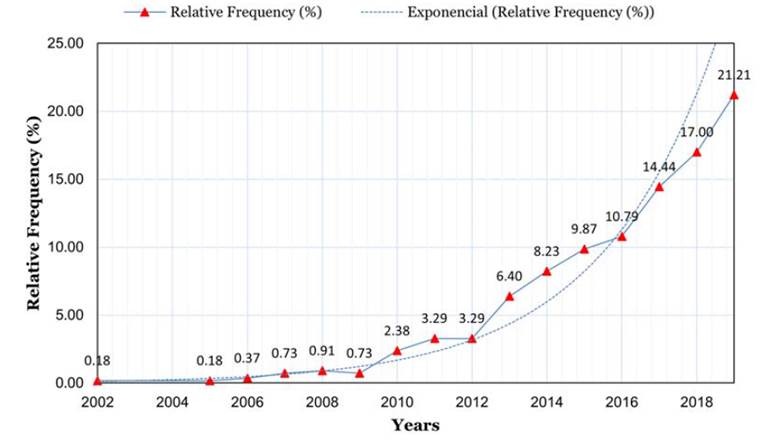
Figure 3 Evolution of sustainable supply chain and renewable energies records in the function of years
The second analysis sought to understand the collaboration network among the main authors. A total of 1.777 authors were found in the database, but none of them had published more than 15 papers over the years. The 10 (ten) authors with the largest number of papers published about the subject were, respectively; You, FQ (with 12 records), Bezzo, F (7), Faaij, APC (7), Junginger, M (7), Ponce-Ortega, JM (7), Zhang, J (7), Cucchiella, F (6), D'Adamo, I (6), Lam, HL (6) and Osmani, A (6).
The author’s collaboration network is presented in Figure 4. There are two strongly connected networks circled in green. There are also small networks, composed of 3 authors or more, and collaboration in pairs. Besides, it is possible to identify the collaboration networks established by the most relevant authors (circled in red in Figure 4). The most relevant authors are: How, BS; Lam, HL; Ng, WPQ; Cucchiella, F; D’Adamo, I; Guo, M; Shah, N; Giarola, S; Bezzo, F; Murphy, RJ; Gonela, V; Osmani, A; Zhang, J. It is important to highlight that Figure 4 considered only those authors with, at least, four publications about the subject.
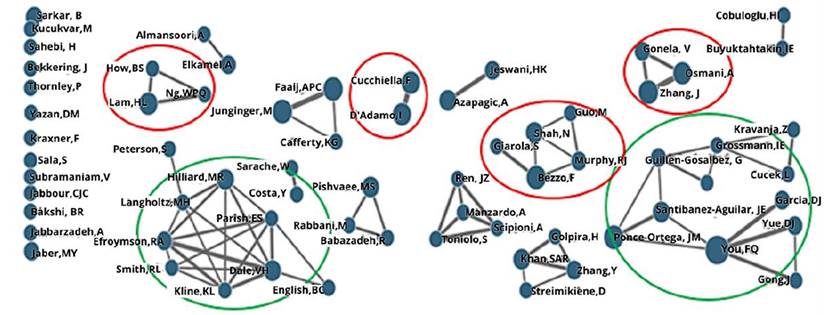
Figure 4 Collaboration networks and micro-networks between the various authors found in the database
Table 2 lists the 28 authors with, at least, 4 publications, while Table 3 shows the 18 most cited authors (the names highlighted with an asterisk in Table 3 are the authors who appeared in both tables). By comparing Tables 2 and 3, we realize that the author with the highest number of papers published about the subject (You, FQ) is also the second most cited author in this database (after only European Comission). Santibanez-Aguillar, JE (4st in Table 2) and Yue D.J. (5st) also appear among the most cited authors (Table 3). In addition, it is observed in Figure 4, that these three mentioned authors have collaboration networks with the most cited and/or among those who publish the most, as the case of Ponce-Ortega and Santibanez-Aguilar, Zhang and Osmani, Bezzo and Shah and others.
Table 2 Authors with the largest number of publications about the sustainable supply chain and RE database
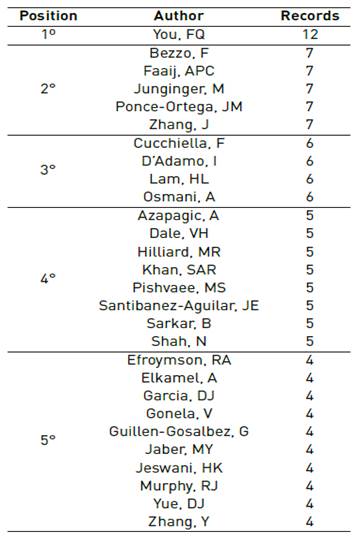
It is also possible to identify the main organizations and institutions that have published the most about the subject of this article. The principal results led to: Imperial College of Science, Technology, and Medicine (with 16 records), University of Padua (14), Iran University Science and Technology (12), University of Utrecht (11), Wageningen University (11), University of Groningen (10), Northwestern University (9), Oak Ridge National Laboratory (9), University of California (9) and University of Manchester (9). It is important to emphasize that there are other institutions besides universities in the database, for example, Natural Resources Canada (4), Argonne National Laboratory (3) and US Forest Service (3).
Note that, despite having 46.1% of renewable sources in the Brazilian Energy Matrix (as discussed in the Introduction), there is no Brazilian organization among the most relevant ones. The Brazilian university that publishes the most about the subject is Federal Fluminense University, with 4 records in the database. UFF is followed by Federal University of Rio de Janeiro - UFRJ (3), São Paulo University - USP (3), Federal Technological University of Paraná - UTFPR (2) and Univ Fed Santa Catarina (2). There are other Brazilian organizations with one record only, including a company in the energy area: Petrobras.
Regarding the countries that published the most about the subject, the top 10 are: USA (with 145 records), United Kingdom (67), Italy (63), Netherlands (45), Germany (34), China (30), Australia (26), Canada (25), Brazil (25) and Malaysia (24). Figure 5 shows the distribution of publications around the world (the colors are related to the number of publications in each country). It is important to note that, although some countries in Africa, the Middle East, and Latin America have not contributed to the research area, it is a topic that has been studied widely on a global scale. The countries with the largest publications by the continent are: the USA in North America (145), Brazil in South America (25), Mexico in Central America (16), UK in Europe (67), China in Asia (30), and Australia in Oceania (26).
Figure 6 lists the collaboration network among the 10 largest publishing countries. It is seen that the USA, Canada, and the UK are in the middle of the network (representing points of connection between the main nations) and that have the largest international collaboration networks.
After analyzing the main authors and their networks, organizations and countries, the next step seeks to understand what the main areas of research are interested in the subject “sustainable supply chains and renewable energies” (Figure 7). As expected, the main results are related to the energy, engineering, and technology areas, as follows: Energy & Fuels (with 221 records - represents 18.60% of the areas), Engineering (213 - 17.93%), Environmental Sciences & Ecology (201 - 16.92%), Science & Technology - Other Topics (157 - 13.22%), Biotechnology & Applied Microbiology (70 - 5.89%), Agriculture (57 - 4.80%), Business & Economics (46 - 3.87%), Thermodynamics (33 - 2.78%), Computer Science (28 - 2.36%) and Operations Research & Management Science (27 - 2.27%).
Other areas were observed that seem not to be directly related to renewable energies but that involve decision-making processes (such as transportation, mathematics, and telecommunication), which leads to a conclusion that the different industrial segments are looking for sustainable alternatives to minimize the environmental impacts in the supply chain.
Figure 8 shows the evolution of the research areas over the years. The first four (Energy & Fuels, Engineering, Environmental Science & Ecology and Science & Technology - Other Topics) increased the number of publications over the last six years, having achieved their greater records in 2019. The other areas presented oscillations over the years.
Besides, it is possible to identify the keywords most recurrent in the studies. As presented in Figure 9, the most frequent keywords are biomass (61), bioenergy (58), biofuel (53), energy (41), renewable energy (41), palm oil (28), bioethanol (19), and others. Also, Figure 10 presents the top 20 keywords and their matching networks with each other, noting that in the middle between all the words, the terms are always seen, sustainability, supply chain, life cycle assessment, biofuel, bioenergy, biomass, optimization, and renewable energy.
Finally, we performed a literature review of the 21 most cited papers about the subject, aiming at identifying the energy sources and the sustainable criteria mentioned in each study. It is important to mention that, despite not having enough citation records to be listed in Table 4, the database gathered other relevant papers that address renewable energy in a sustainable supply chain that might be investigated by researchers interested in the subject. Besides, the papers published in the last three years could be analyzed in future works in order to identify novelties and different approaches in the area.
Table 4 Mapping of the most cited works about sustainable supply chain and RE

1TPP - Thermal Power Plant, 2PV - Photovoltaic, 3RE - Renewable Energy, 4EU - Europe Union, 5MCDM - Multi-Criteria Decision-Making, 6SBSC - switchgrass-based bioethanol supply chain, 7MINLP - Mixed-integer nonlinear programming. * The type of supply chain is not explicit in the paper.
Note that You, FQ; Lam, HL; Yue,DJ; Cucchiella, F; D'Adamo, I and Khan, SAR (the main authors presented in Table 2), have papers listed among the most cited in Table 4. Another important fact is that some of the most cited articles were published in the last five years (2016 and 2018).
Regarding the goals of each paper, we realize that renewable energy in the supply chain is a broad area of interest, as previously presented in Figures 7 and 8. Therefore, some papers evaluate and/or propose mathematical models to enhance energy performance, while others only compare the performance of different systems and/or studies novel sources of biofuels.
Moreover, Table 6 shows the frequency of each source energy, sustainable criteria and supply chain presented in Table 5. Although the findings cannot be extended to the entire database, it was identified that biomass and photovoltaic were the most investigated renewable sources in Table 4, as well as, biofuel and bioenergy were the most studied type of supply chain. Cost (an economic indicator) and CO2 and GHG emissions (an environmental indicator) were the sustainable criteria more recurrent in the database. It is in accordance with the literature 41,45,80 that points out the difficulty in considering social indicators. When the social impact is evaluated, job creation is the indicator addressed the most.
At the end, we can point out that renewable energy is a topic of interest in sustainable supply chain studies all over the world. However, incorporating the social aspects might be a challenge for future studies, as it is in other areas as transportation 45 and facility location (33,42,58.
4. Conclusion
In this paper, we answered some questions related to the main researchers, institutions, and countries that have been investigating about sustainable supply chain and renewable energy, the increase or decrease about publications within this area, and the most significant issues related to this subject. After answering them, it was possible to map the role of renewable energies in the context of the sustainable supply chain, from the literature published at Web of Science database - WoS until 2019.
This paper showed that the investigation of renewable energies in the sustainable supply chain is a recent concern: the first paper published about the subject was in 2002, but there was an intensification on its growth only from 2010. Among the most cited papers, only three were published before 2010.
Furthermore, this research showed that different countries and institutions around the world are searching for solutions related to renewable energies in the supply chain (as can be seen in Figure 5). Another important remark is that different industrial sectors have developed research in this area, ranging from the pharmaceutical to food industry, according to Figure 7.
This research also showed a diversity of renewable energy sources that have been investigated, from biomass, biofuels, and bioenergy, to photovoltaic, wind energy and biogas. Regarding the sustainable criteria, we identified emphasis in the economic (cost) and environmental (GHG or specifically CO2 emissions) among the 21 most cited papers. However, we must emphasize that a social criterion was mentioned in four papers: job creation. It reinforces that considering the triple bottom line is a challenge for future studies.
It is important to mention that despite representing only 5.7% of the papers published about sustainable supply chains at WoS, there are more than 500 papers investigating the role of renewable in the search for more sustainable supply chains. Likewise, it is relevant to highlight that the literature points out the development of biofuels and renewable sources of energy as eco-friendly policies themselves. These ecofriendly policies aim to reduce the environmental impact, especially consumption of fossil fuels, depletion of natural resources, and CO2 emissions level 30,31. Therefore, we have answered the main question of this research.
As limitations of this research, we highlight that the coverage of this research included only the papers published on the Web of Science database, and the results are directly influenced by the keywords selected for the review. Besides, a literature review was performed only with the 21 most cited papers (about 3.83% of the database).
As suggestions, we point out that future works could investigate other aspects of the sustainable supply chain database, segregating the studies by type of supply chain or renewable energy. Besides, further analysis could propose a theoretical framework to help in the assessment of the economic, social, and environmental dimensions in the sustainable supply chain.














